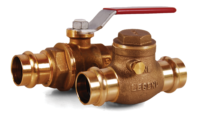MilwaukeeValve Co. has manufactured drinking water valves for many decades. In association with requirements for our industry and products, we’ve been closely following the rapidly changing legal landscape in this area. In 2003, Milwaukee Valve became the first U.S. valve company to offer a bronze valve that met the requirements of NSF 61. Later that same year, multiple lines of brass plumbing valves also meeting this standard were introduced.
More recently, the California requirements for limitation of lead in valves to less than .25% on a total weight basis have been driving the industry and the rest of the regulatory landscape, so that most valve makers are rushing now to produce valves that meet the much-tighter limit.
This leaves us — property owners, specifying engineers, contractors, distributors and manufacturers — having to deal with a new set of requirements, products and materials, not by choice, but by legislation. As with anything else, there’s a learning curve for us to go through.
In life, you often have to give up something in order to get something. That’s certainly true when it comes to these new low-lead and no-lead alloys. To achieve very low lead, you give up other things: ease and low cost to cast and machine the alloys, forgiveness to mechanical and thermal loading in the finished product, as well as other uses and abuses it might be subjected to in the field.
This doesn’t mean that a new low-lead valve or fitting from a reputable manufacturer isn’t fit for sale, but it does mean that size for size, item for item, the low/no-lead item will not be as resistant to abuse. Installing contractors need to be especially mindful of good practice rules that need to be followed in order to avoid problems or premature product failure.
The first and most important thing to consider in this regard is, “Does the valve type I’m trying to install need to meet these new specs?” For example, small ball valves primarily intended for natural gas service might not ever need to be made from the low-lead alloys.
A real situation has developed in the industry over the last several months where a major supplier of valves for both gas and water introduced a gas valve product made from the low-lead alloy. This low-lead product has subsequently experienced cracking in the field and is now involved in a recall.
Another rule of thumb that must be followed when installing low- and no-lead valves is that solder-end valves must not be overheated, as the resulting high thermal stresses can damage or fracture the valve. Piping should be arranged such that no elbows, tees or other heavy components, as well as pressure- or flow-direction-changing items, are ever close-coupled to the valve. Close-coupling items like these causes more complicated loading of the valve.
If a reasonable length of straight tubing isolates the valve from these other items, the loads resulting from alignment or temperature changes can resolve in the tubing so that the valve experiences only simple loading, to which it will be much more resistant.
Other valve types are being produced from low-lead alloys, including bronze gate, globe and check valves that are intended for steam service. Milwaukee Valve is taking a more conservative stance, especially where safety issues might be involved. This is certainly true in the cases of both gas and steam service, which are well-met by products on the market today. In addition, there is a real cost savings to using the correct valve.
The purpose of this editorial is to provoke thought so that purchasing decisions are made in the long-term best interests of your projects and all involved parties, with safety as the chief consideration. If you are in front of a manufacturer or a manufacturers representative who is trying to get you to switch to a low-lead or no-lead valve for anything other than ordinary drinking water applications, don’t be misled.
About the author: Geoff McLaughlin has been in the industrial and commercial valve business for more than 25 years, the last half of which he’s spent at Milwaukee Valve in engineering and sales management positions.




